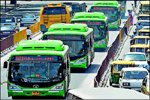On average, two people die on Mumbai’s roads owing to traffic crashes every day. The city ranks seventh in the country in terms of absolute numbers of road traffic fatalities. Pedestrians, cyclists and motorcyclists are most vulnerable, and are involved in more than 90 percent of all road traffic fatalities. Young working populations – mostly men – are particularly affected. ...
Tag Archives: Urban Transport
Rickshaws for Last Mile Connectivity
As the name signifies, last mile connectivity (LMC) implies connecting services to the end point. In the context of urban transport, the term finds relevance in public transit systems where it is referred to as both the initial and the final leg of delivering connectivity – from origin to transit system and from transit system to destination. Last mile connecting ...
Integrating women’s concerns in public transport
Since December 2012, there has been increased attention to women’s experience of public transport. While the demand to make public transport safer for women is rightly emphasized, there is a need for a holistic approach to “engender public transport” i.e. making men and women’s concerns an integral part of the design, implementation, monitoring and evaluation (UNESCO 1997) of public transport. ...
State-of-the-Art or Fit-for-Purpose
Adopting state-of-the-art techniques just for personal vanity or CV building is likely to backfire in developing economies like India. India has quite different baseline conditions from western cities, more than simple quantitative differences in income levels and a different vehicle mix. Such differences must be borne in mind when determining ways to analyse the transport patterns for new transport infrastructure and policies, writes Richard Di Bona.
Urban transport tax in the offing
The central government is planning to introduce a one-time urban transport tax on private vehicles in an effort to encourage use of public transport and discourage the use of private vehicles. According to urban transport experts mega cities have 10% of total vehicles in the country, of which 90% are private vehicles. For existing vehicles the urban transport tax will ...
TrafficInfraTech Expo 2012 Successful Eventful Bountiful
TrafficInfraTech Expo 2012 in Mumbai lived up to the industry’s expectations from it. Ministries, government officers from various State Authorities & PWDs, Senior Traffic Police Officers, serious buyers, and many other trade specific visitors kept the exhibitors on their toes. TrafficInfraTech takes you to the scene of action of India’s most looked forward to Traffic Show. When over 78 exhibitors ...
DIMTS and Delhi Government bag award
The Delhi Government and Delhi were awarded the ‘Best PPP initiative in Urban Transport’ award for the project ‘Corporatisation of Private Stage Carriage Buses in Delhi’ at the recently held Urban Mobility Conference. DIMTS monitors and manages the operations of the cluster buses on behalf of the Delhi Government. Currently, 150 cluster buses are operating on the road. The cluster ...
Public Transport : The smart green solution
Public Transport : The smart green solution The International Association of Public Transport (UITP) unveiled its vision for urban transport in 2025 at the UITP Dubai 2011 World Congress in April. It compared the economic, environmental and social impact of urban transport in a business-as-usual (BAU) scenario and in a ‘PTx2’ scenario. Based on well-documented urban economic and technological development ...
Urban Transport Energy Consumption:Determinants and Strategies for its Reduction
The adoption of faster modes of transport has changed profoundly the spatial organisation of cities. The increase in average speed of a city's transport system calls for more space. The result is urban sprawl and reduced density. Dominant transport modes are, therefore, the determinants of urban structures. The increase in distance covered due to increased speed of travel and urban sprawl leads to an increase in energy consumption.
 TrafficInfraTech Magazine Linking People Places & Progress
TrafficInfraTech Magazine Linking People Places & Progress








